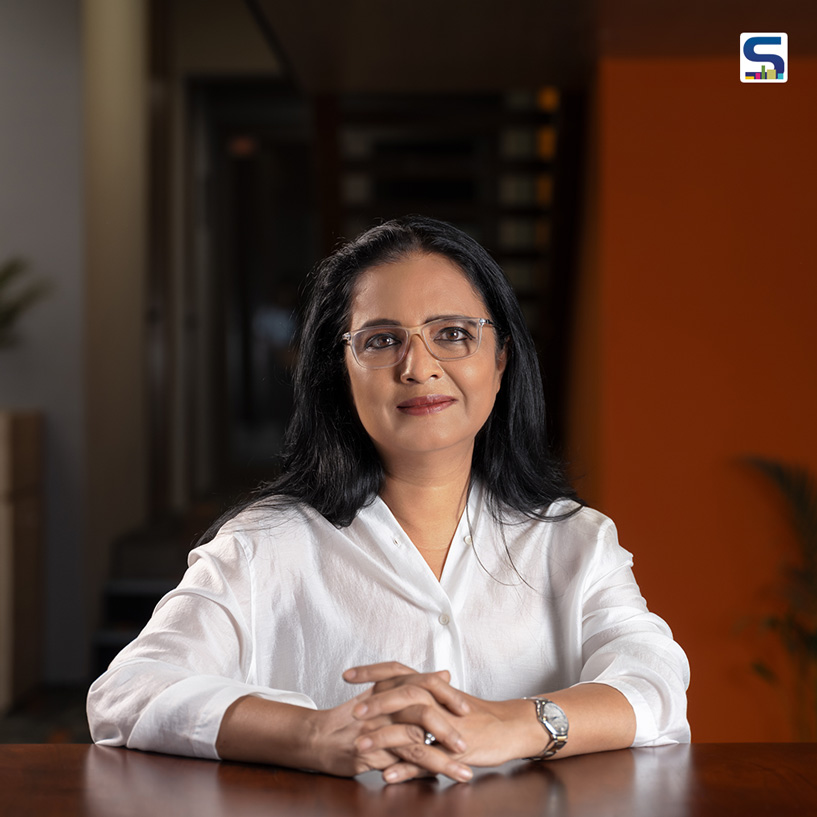
Ar Sonali Rastogi, Founding Partner at Morphogenesis in Delhi, is one of the most versatile architects in the current design scenario. As the principal designer of the Surat Diamond Bourse, along with her partner Manit Rastogi, the world’s largest office building at over 7.1 million sq. ft., Sonali has recently spoken about the transformative powers of architecture and how it shapes the identity of a city in a brief report by SURFACES REPORTER. Ar Sonali Rastogi also spoke as the Keynote Speaker during the recently concluded WADE ASIA 2023.
The Transformative power of Architecture
In an article published in The Hindu, Ar Sonali Rastogi spoke about the crucial nature of architecture in weaving the rich tapestry of urban development along with the economic prosperity of the region. For instance, iconic monuments like the Bilbao Guggenheim in Spain (1997), The Gherkin tower in London (2004), and the revitalized new World Trade Center complex in New York are not only architectural marvels but also act as catalysts for socio-cultural and economic resurgence. Calling it the 'Bilbao Effect,' she stated that a similar role used to be played by the Ghats in India at major riverfronts by bringing various communities together.
Indian Perspective
With the launch of projects such as the Gujarat International Finance Tec-City (GIFT City) in Gandhinagar and the Surat Diamond Bourse in Surat, India's urban landscape is also set to transform.
She writes for The Hindu, "The economic impact of these projects extends far beyond their physical footprint. They become magnets for tourism, generate employment opportunities, spur infrastructural development in the surroundings, and elevate the regional image, all contributing to overall economic growth. Public spaces, integral to this equation, foster social bonds that stimulate innovation and employment, turning these architectural marvels into hubs of societal growth."
Such buildings are not only architecturally 'striking' but are equally meaningful, acting as the existential foothold in cities across the world. With the world getting smaller and interconnected and mobile societies, iconic buildings such as the Bilbao Museum and Surat Diamond Bourse become more than just physical structures and embody the spirit and aspirations of communities.
World Buildings
In the article, Sonali takes a detour of the world cities and cites numerous examples of how landmark buildings transcend beyond their physical forms and shape the global identity of the respective cities by using the interplay of form, material, location, time, context, and marketing strategies.
Take, for example, the Sydney Opera House - the architectural masterpiece's distinctive sail-like profile positioned at the water's edge has become synonymous with Sydney's skyline on the global stage, bolstering its tourism industry. Visiting New York City and Kuala Lumpur, Sonali takes note of the High Line Building and Petronas Tower, respectively. While the former has been transformed into an elevated, biodiverse park from a derelict railway infrastructure, becoming an urban renewal initiative worldwide, the latter, once the tallest building in the world, spurred urban development in Southeast Asia, attracting businesses and tourists alike.
She also spoke about the Royal Villas of the Kingdom of Swaziland that showcase a fusion of traditional Swazi architecture with modern design, becoming the identity of luxury tourism in the country.
Who is Sonali Rastogi?
Sonali has worked across a diverse canvas ranging from architecture to urban design, landscape, interior design, and art & sculpture. Her professional portfolio includes several significant institutions, select residences, hotels, commercial buildings, residential complexes, and Smart Cities across India, Bhutan, South Africa, Nepal, Bangladesh, The UAE, Sri Lanka, and Afghanistan. She believes that each project must establish itself as a benchmark for innovative design by thinking systemically about sustainability to create a large-scale impact. This has resulted in the formulation of Morphogenesis’ copyrighted design philosophy S.O.U. L ©, an acronym for Sustainable, Optimized, Unique, and Livable.